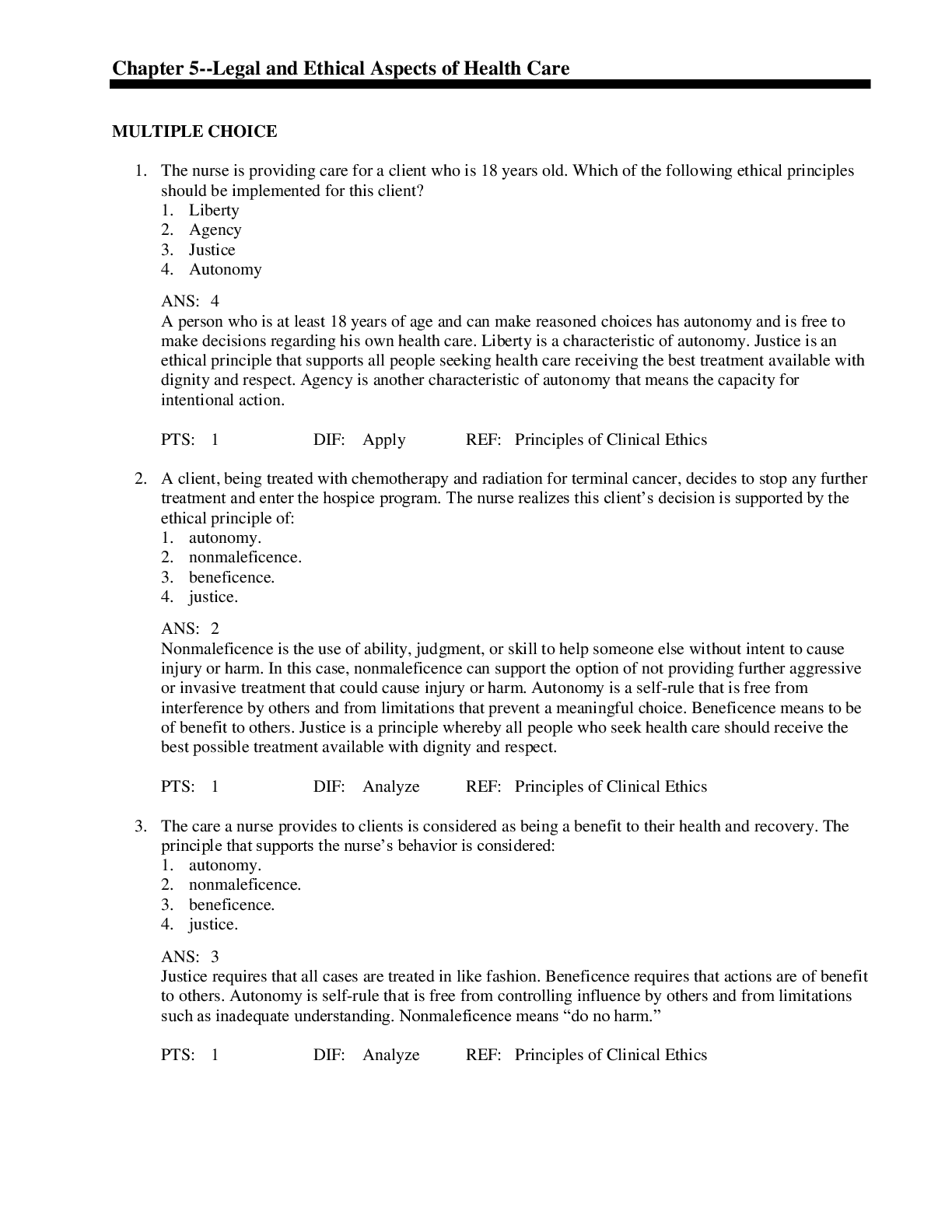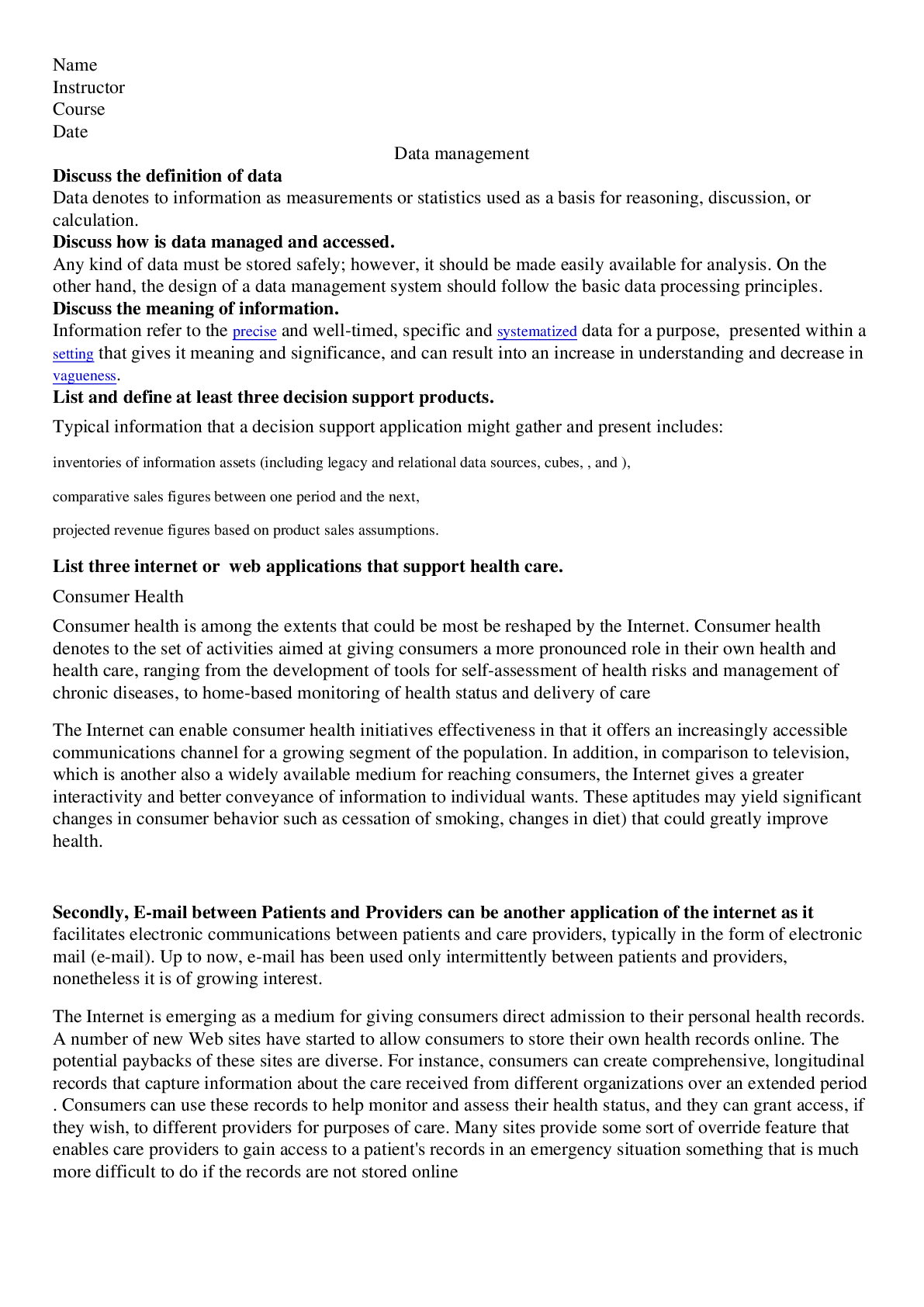*NURSING > QUESTIONS & ANSWERS > Chapter 5--Legal and Ethical Aspects of Health Care (All)
Chapter 5--Legal and Ethical Aspects of Health Care
Document Content and Description Below
Chapter 5--Legal and Ethical Aspects of Health Care MULTIPLE CHOICE 1. The nurse is providing care for a client who is 18 years old. Which of the following ethical principles should be implemen... ted for this client? 1. Liberty 2. Agency 3. Justice 4. Autonomy PTS: 1 DIF: Apply REF: Principles of Clinical Ethics 2. A client, being treated with chemotherapy and radiation for terminal cancer, decides to stop any further treatment and enter the hospice program. The nurse realizes this client’s decision is supported by the ethical principle of: 1. autonomy. 2. nonmaleficence. 3. beneficence. 4. justice. PTS: 1 DIF: Analyze REF: Principles of Clinical Ethics 3. The care a nurse provides to clients is considered as being a benefit to their health and recovery. The principle that supports the nurse’s behavior is considered: 1. autonomy. 2. nonmaleficence. 3. beneficence. 4. justice. PTS: 1 DIF: Analyze REF: Principles of Clinical Ethics 4. A client recovering from surgery does not want to move out of bed because of pain. The nurse explains the long-term effects of staying in bed and the benefits of movement. The client agrees and is assisted out of bed. This is an example of: 1. autonomy. 2. nonmaleficence. 3. beneficence. 4. justice. PTS: 1 DIF: Analyze REF: Principles of Clinical Ethics 5. The nurse who bases client care actions on the principle of “greatest good” is implementing which ethical theory? 1. Teleology 2. Deontology 3. Utilitarian 4. Justice PTS: 1 DIF: Apply REF: Ethical Theories 6. The nurse is preparing a consent form for a client to sign before a procedure. Which of the following statements explains a characteristic of informed consent? 1. The client does not need autonomy to give consent. 2. Minors are permitted to give consent. 3. The client does not need to give consent if the situation is an emergency. 4. If the client is of legal age, he or she does not need the cognitive ability to understand. PTS: 1 DIF: Analyze REF: Informed Consent 7. When the nurse obtains a client’s signature for informed consent, the nurse’s responsibility is the verification that: 1. the client understands everything about the procedure. 2. a family member witnesses the signature. 3. the client was not coerced into signing the form. 4. the client has asked questions. PTS: 1 DIF: Apply REF: Informed Consent 8. The health care team is addressing an ethical issue regarding one client’s continuing care. The nurse wants to ensure that the principle of justice is taken into consideration. Which of the following ethical decision-making modules would support this principle? 1. Medical indications 2. Patient preferences 3. Quality of life 4. Contextual features PTS: 1 DIF: Apply REF: Ethical Decision Making Models 9. The nurse, caring for an elderly client recovering from a fractured coccyx, wants to discuss palliative care. The client becomes alarmed and asks “is there something you aren’t telling me? Am I dying?” Which of the following should the nurse respond? 1. “We are all dying.” 2. “It’s an approach to care to help relieve pain and provide you with support.” 3. “It’s care provided to all elderly patients.” 4. “Since it is covered by Medicare, you are entitled to it.” PTS: 1 DIF: Apply REF: Hospice and Palliative Care 10. The nurse provides a terminally ill client with dose of a newly prescribed pain medication. Shortly afterwards, the client experiences respiratory arrest and dies. Which of the following describes this client scenario? 1. Euthanasia 2. Assisted suicide 3. Intended effect 4. Double effect ANS: 4 PTS: 1 DIF: Analyze REF: Concept of Double Effect 11. An elderly client with septic leg wounds develops multi-system organ failure. The physicians discuss treatment options with the family but explain that success to reverse the condition is minimal. The family has decided to stop all further treatment of the client. This scenario is an example of: 1. medical futility. 2. do-not-resuscitate. 3. assisted suicide. 4. active euthanasia. PTS: 1 DIF: Analyze REF: Limitation of Treatment 12. A client is asked to participate in a research study. The client does not want to participate but does not want to seem unwilling to receive treatment for an illness. Which of the following should the nurse explain to this client? 1. Negative effects from research rarely occur. 2. It is an honor to be asked to participate in a research study. 3. Refusing to participate is the client’s right. 4. The physician wants the client to participate. PTS: 1 DIF: Apply REF: Research Ethics 13. The nurse caring for elderly clients begins to experience anger, guilt, and frustration over the prescribed medical treatments for the clients. The nurse is demonstrating which of the following? 1. Moral distress 2. Burnout 3. Signs of a chronic illness 4. Evidence of an acute illness PTS: 1 DIF: Analyze REF: Moral Distress MULTIPLE RESPONSE 1. The nurse is analyzing the main principles of clinical ethics prior to planning care for a client. Which of the following are considered the main principles of clinical ethics? (Select all that apply.) 1. Malfeasance 2. Autonomy 3. Liberty 4. Nonmaleficence 5. Beneficence 6. Justice PTS: 1 DIF: Analyze REF: Principles of Clinical Ethics 2. A client, hospitalized with an extensive cerebral vascular accident, is unable to make any treatment decisions. Which of the following documents addresses the client’s treatment choices? (Select all that apply.) 1. Living will 2. Durable power of attorney for health care 3. Incident report 4. Verbal advance directive 5. Advance directive 6. Medication administration record PTS: 1 DIF: Apply REF: Advance Directives 3. The nurse is confronted with an ethical decision regarding a client’s continuing care. Which of the following approaches can be used to reach a decision for this client? (Select all that apply.) 1. Medical indications 2. Client preferences 3. Quality of life 4. Health insurance plan 5. Contextual features 6. Integrated model PTS: 1 DIF: Apply REF: Ethical Decision Making Models 4. An elderly terminally ill client is experiencing apnea periods and within an hour, dies. No efforts were provided to resuscitate this client. Which of the following would describe this client event? 1. Do-not-resuscitate 2. Coma depasse 3. Brain death 4. Passive euthanasia 5. Assisted suicide 6. Active euthanasia PTS: 1 DIF: Analyze REF: Euthanasia and Assisted Suicide 5. The nurse reviews the American Nurses Association’s Code of Ethics for Nurses. Which of the following is included in this code? 1. Care is provided with compassion and respect. 2. Primary commitment is to the client. 3. Strive to protect the health, safety, and rights of the client. 4. Delegation is not an option. 5. Client needs supercede those of the nurse. 6. Collaboration with other health care professionals is expected. PTS: 1 DIF: Analyze REF: Box 5-1 The ANA Code of Ethics for Nurses [Show More]
Last updated: 1 year ago
Preview 1 out of 6 pages
Instant download

Buy this document to get the full access instantly
Instant Download Access after purchase
Add to cartInstant download
Reviews( 0 )
Document information
Connected school, study & course
About the document
Uploaded On
Jan 21, 2020
Number of pages
6
Written in
Additional information
This document has been written for:
Uploaded
Jan 21, 2020
Downloads
0
Views
62
















 Questions with Complete Answers.png)

